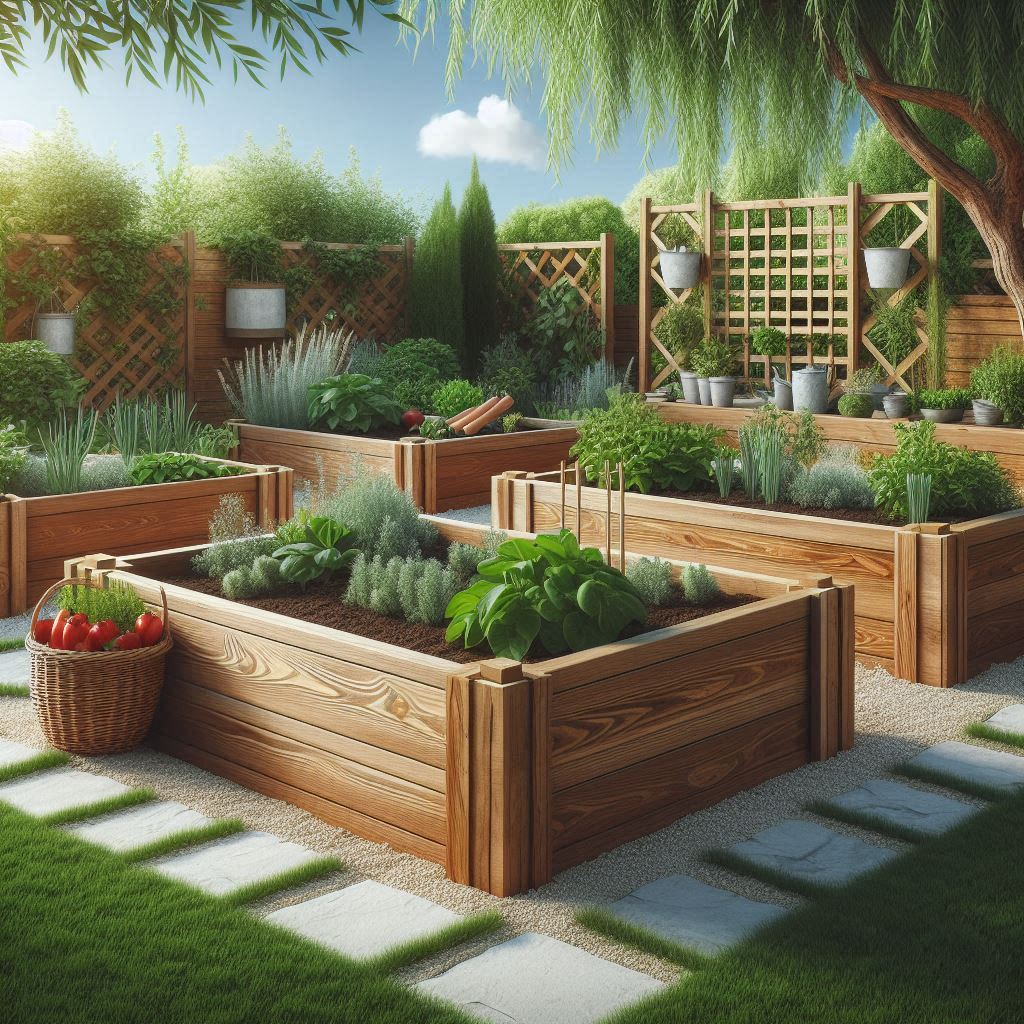Ever dreamed of having a flourishing garden but felt discouraged by the limitations of your yard or lack of experience? Raised garden beds are the perfect solution! They offer a wealth of benefits for gardeners of all levels, and the best part? You can easily build your own using readily available materials and these free plans.
Why Choose a Raised Garden Bed?
Raised garden beds offer a multitude of advantages over traditional in-ground gardens:
- Improved Soil Quality: You have complete control over the quality of the soil in your raised bed. Fill it with a nutrient-rich mixture specifically chosen for your desired plants, unlike native soil which can be poor or compacted.
- Better Drainage: Raised beds provide superior drainage, preventing plants from rotting due to waterlogged soil. This is especially crucial for vegetables and herbs that thrive in well-drained conditions.
- Easier Maintenance: Raised beds reduce the need for weeding and tilling. The defined edges keep weeds at bay, and the elevated height allows for comfortable gardening without bending over excessively.
- Pest Control: Raised beds create a physical barrier, making it harder for unwanted pests like rabbits and slugs to access your precious plants.
- Extended Growing Season: In some climates, raised beds can extend your growing season. The dark soil absorbs heat more readily, allowing you to plant earlier in the spring and harvest later in the fall.
- Versatility: Raised beds can be built in various sizes and shapes to fit any space, making them ideal for small patios, balconies, or backyards. They can also be customized with different materials and styles to complement your existing landscaping.
Unleash Your Inner Gardener: 15 DIY Raised Bed Ideas
Now that you’re sold on the benefits of raised beds, here are 15 free plans and ideas, ranging from classic wooden designs to creative upcycled options:
1. The Classic Wooden Raised Garden Bed:
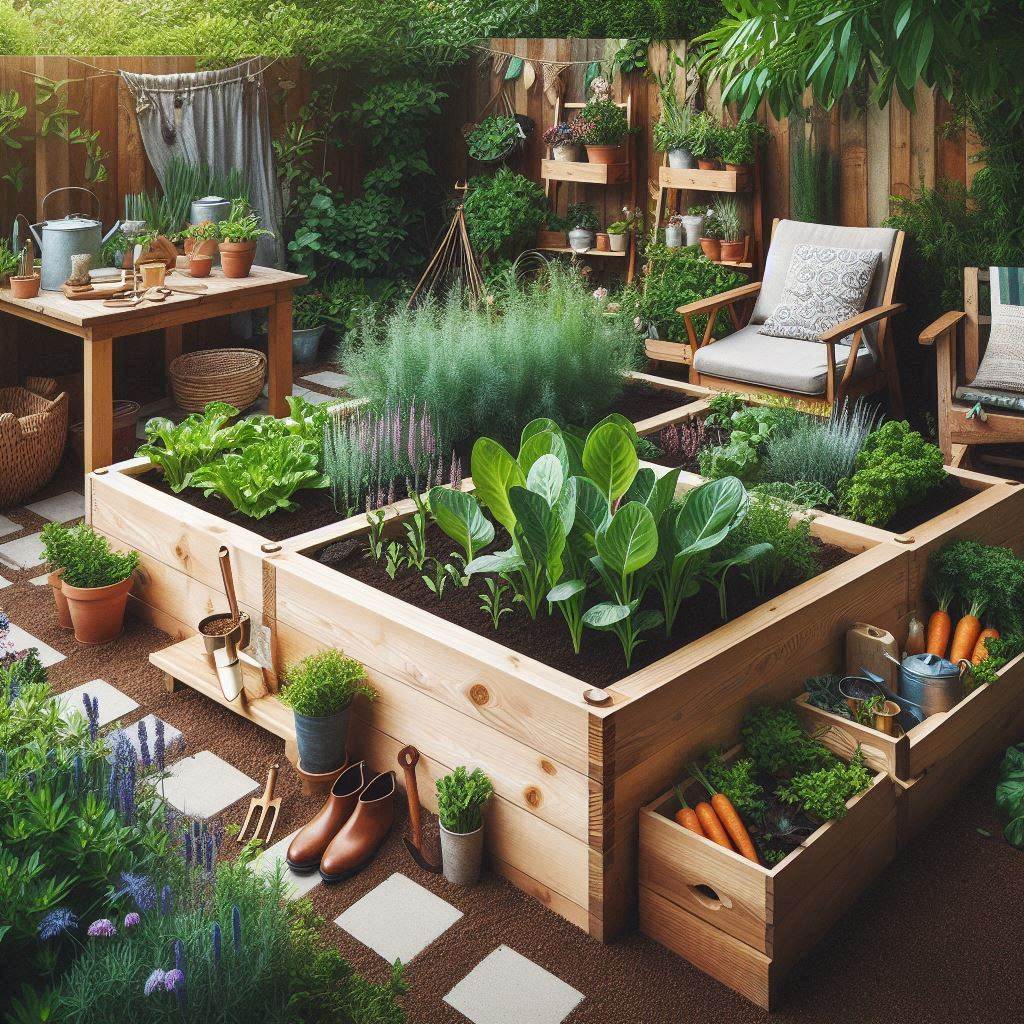
This is the go-to design for a sturdy and attractive raised bed. Here’s what you’ll need:
Materials:
- Pressure-treated lumber (enough for your desired size, typically 1×8 or 2×6 boards)
- Galvanized screws (appropriate length for wood thickness)
- Drill
- Saw (optional, if pre-cut lumber isn’t purchased)
- Wood stain (optional)
Estimated Cost: The cost will vary depending on the size of your bed and lumber prices. However, a basic 4′ x 8′ raised bed can be built for around $50-$75.
Instructions:
- Cut the lumber: Measure and cut your boards to the desired length for the sides and ends of the raised bed. Ensure all cuts are square for a clean assembly.
- Assemble the frame: Lay the boards flat, forming a rectangle. Pre-drill pilot holes to prevent wood splitting, then screw the boards together securely. Repeat for all four sides.
- Attach the sides to the ends: Stand the side panels upright and connect them to the end pieces using screws. Double-check for square corners throughout the process.
- (Optional) Staining: Allow the assembled frame to dry completely. Apply a coat of exterior wood stain or weatherproof paint for added protection and aesthetics. Let the stain dry thoroughly before filling the bed with soil.
Tips:
- Choose pressure-treated lumber specifically designed for outdoor use. It resists rot and warping, ensuring your raised bed lasts for years.
- You can adjust the size of the bed to fit your space and needs. A common size is 4′ x 8′, but raised beds can be as small as 2′ x 3′ or as large as desired.
- Consider lining the bottom of the raised bed with landscape fabric to suppress weeds and prevent soil erosion.
2. Repurposed Wood Raised Garden Bed:
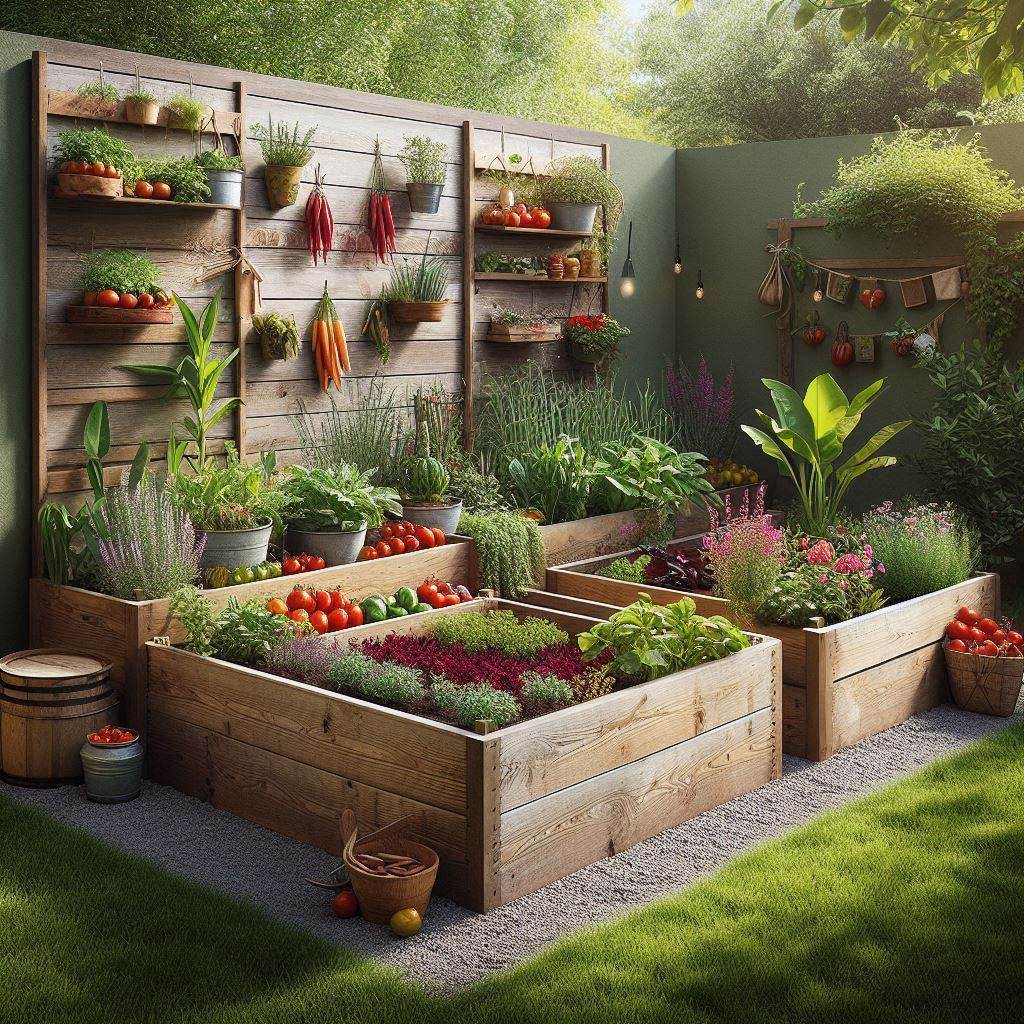
Don’t have new lumber on hand? Look around for scrap wood or consider deconstructing old furniture for a rustic and eco-friendly raised bed.
Materials:
- Reclaimed wood (enough for your desired size)
- Screws
- Drill
- Sandpaper (optional)
Estimated Cost: This option can be very cost-effective, potentially free if you source the wood yourself.
Instructions:
- Prepare the wood: Disassemble any unwanted furniture or structures to obtain usable wood pieces. Ensure the wood is relatively sturdy and free of excessive rot or warping.
- Cut and sand: Cut the reclaimed wood to the desired lengths for the raised bed frame. Sand down any rough edges to ensure a smooth finish, especially if the wood is weathered.
- Assemble the frame: Following the same steps as the classic wooden raised bed plan, assemble the frame using screws and pre-drilled pilot holes. Be mindful of any irregularities in the reclaimed wood and adjust accordingly to achieve a sturdy structure.
Tips:
- Look for free pallets, discarded fence boards, or demolition scraps as potential sources of reclaimed wood.
- Choose the sturdiest pieces of wood available. Avoid using wood that is cracked, warped, or excessively soft.
- If some of the wood shows signs of rot, you can try treating it with a wood stabilizer before using it in your raised bed. However, heavily rotted wood should be discarded.
3. Pallet Raised Garden Bed:
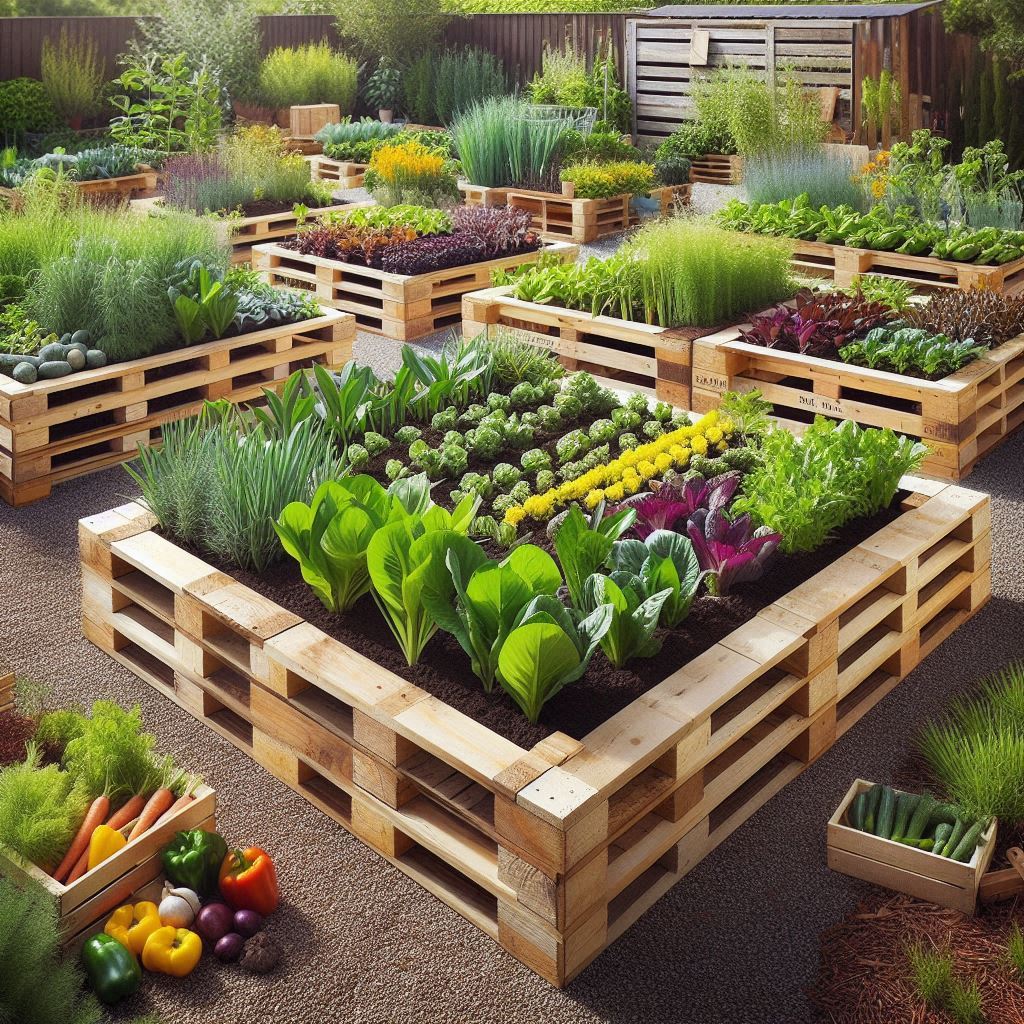
Pallet gardens are a fantastic budget-friendly option for beginner gardeners. Pallets can often be found for free or at a very low cost.
Materials:
- Wooden pallets (ensure they are untreated and safe for gardening)
- Hammer
- Nails or screws (depending on pallet construction)
Estimated Cost: Minimal. You may need to purchase nails or screws if the pallets are not already assembled.
Instructions:
- Disassemble the pallets (optional): Some pallets can be used whole for a raised bed. However, if you prefer a taller bed or a specific size, carefully disassemble the pallets using a hammer to pry apart the boards.
- Select the best wood: Choose the sturdiest boards from the disassembled pallets. Discard any broken, warped, or excessively weathered pieces.
- Assemble the frame: Lay the pallet boards flat to create the desired size and shape for your raised bed. Use nails or screws to securely fasten the boards together.
Tips:
- Make sure the pallets you use are untreated and labeled “HT” for heat-treated lumber. Avoid pallets stamped with “MB” (methyl bromide), which can be harmful to plants.
- Reinforce the corners and sides of your pallet bed for added stability. You can use additional scrap wood or metal brackets for this purpose.
- Line the bottom of your pallet raised bed with landscape fabric to prevent soil erosion and weed growth.
4. Straw Bale Raised Garden Bed:
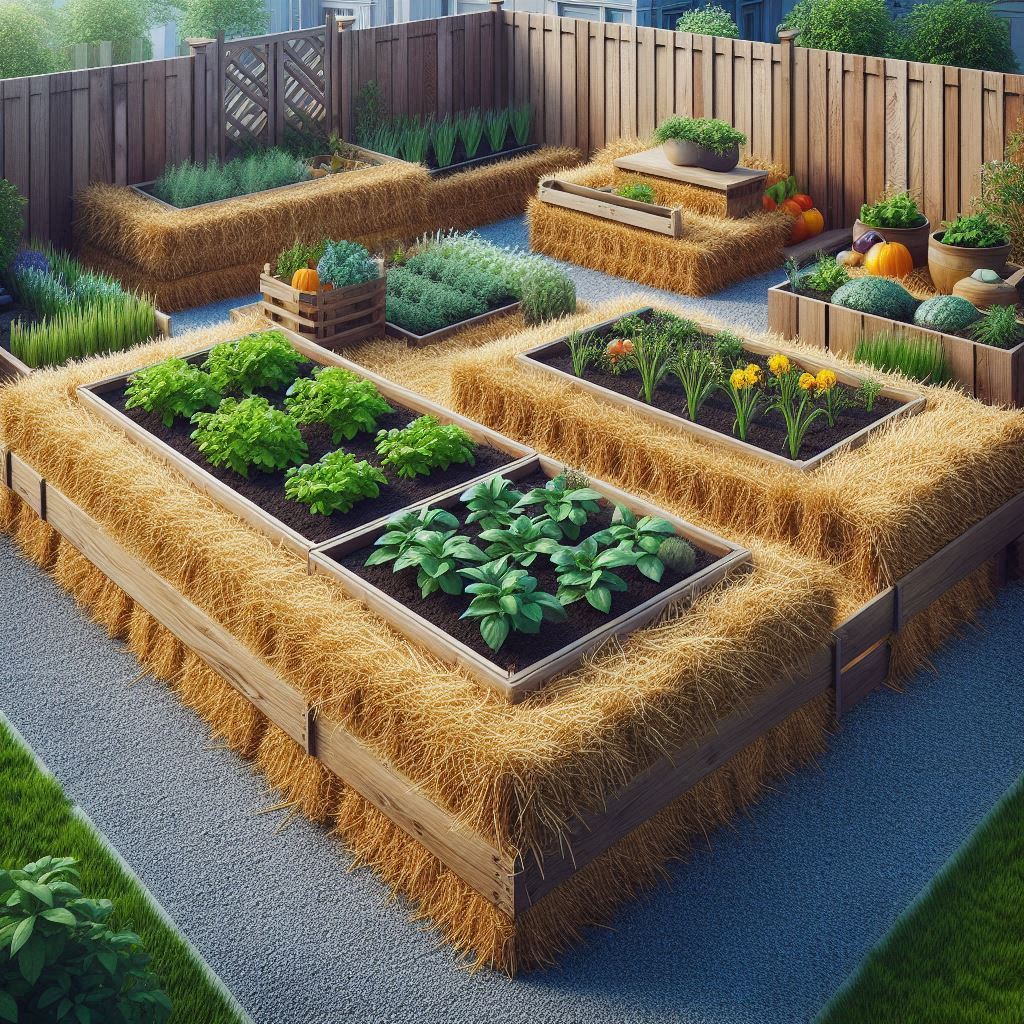
Straw bale gardening is a unique and organic approach to raised beds. Straw bales decompose over time, providing nutrients to your plants.
Materials:
- Straw bales (ensure they are weed-free and oat or wheat straw)
- Twine or rope
- Optional: Shade cloth
Estimated Cost: The cost will depend on the number of straw bales needed and their availability in your area.
Instructions:
- Prepare the location: Choose a sunny spot in your garden with good drainage.
- Condition the bales (optional): If planting right away isn’t possible, you can “condition” the bales by soaking them thoroughly and allowing them to dry partially. Repeat this process a few times over a couple of weeks to encourage some decomposition.
- Stack the bales: Lay the straw bales flat, end to end, in a single row for a low raised bed or double stacked in a staggered formation for a taller bed. Secure the bales together using twine or rope.
Tips:
- Choose high-quality straw bales free of weeds and seeds. Avoid straw containing hay or other plant material, as this can attract unwanted pests.
- Place a layer of cardboard or weed mat underneath the straw bales to suppress weeds growing through the bottom.
- Straw bales can dry out quickly, especially in hot climates. Consider using shade cloth on the south-facing side of the bales to retain moisture.
5. Keyhole Garden Bed:
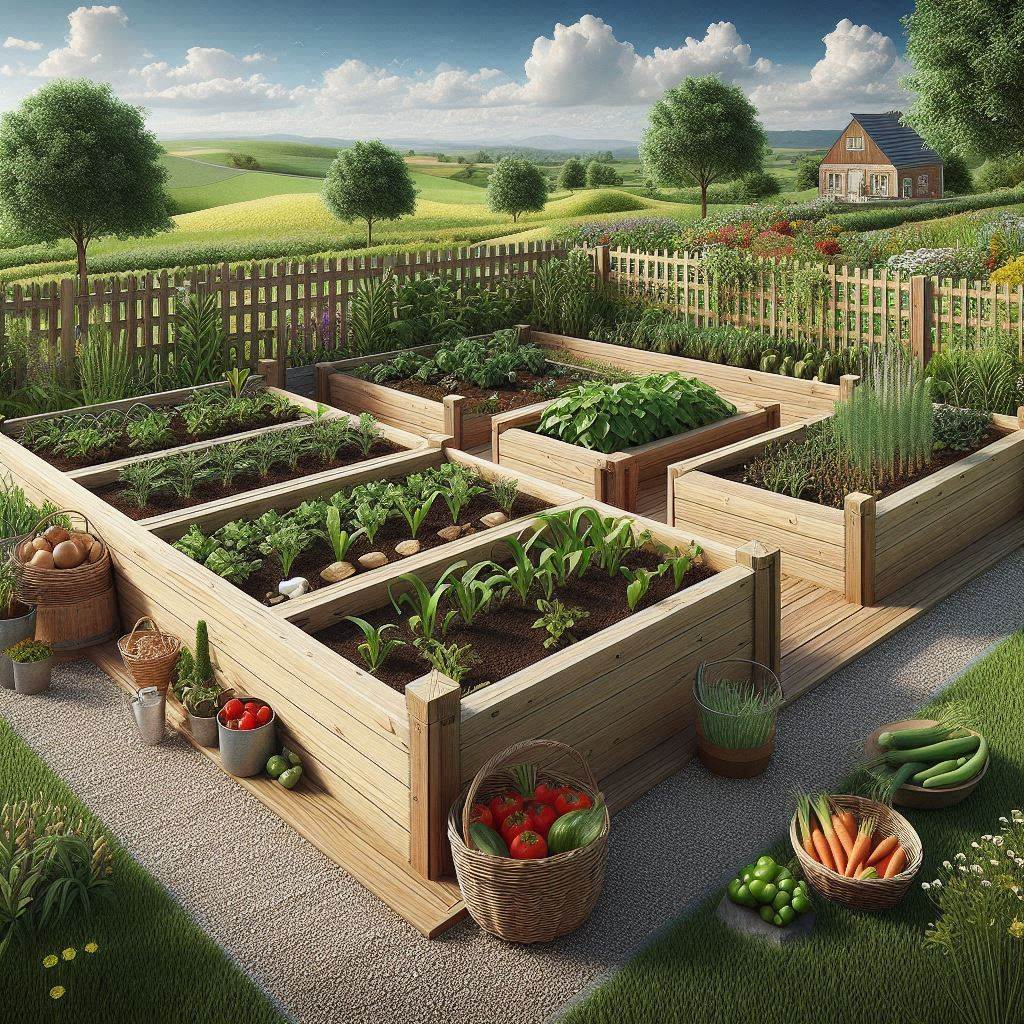
This innovative design offers easy access to the center planting area, making it ideal for smaller spaces or those with limited mobility.
Materials:
- Lumber (enough for your desired size, typically 1×6 or 2×4 boards)
- Screws
- Drill
- Saw (optional, if pre-cut lumber isn’t purchased)
Estimated Cost: Similar to the classic wooden raised bed, the cost depends on the size and lumber prices. A basic keyhole bed can be built for around $30-$50.
Instructions:
- Cut the lumber: Following a keyhole garden template found online or creating your own, cut the lumber pieces for the sides, back, and curved front section.
- Assemble the frame: Build the frame using screws and pre-drilled pilot holes. The keyhole section will typically be a curved piece attached to the straight back panel. Ensure all corners are square for a sturdy structure. 3. Attach the sides: Secure the side panels to the back and curved front section using screws. Double-check for a level and stable frame.
Tips:
- Due to the smaller size and single access point, keyhole gardens are best suited for herbs, leafy greens, or other smaller vegetables.
- To maximize planting space, consider using a vertical planting technique within the keyhole section. This can be achieved by attaching mesh pockets or hanging planters inside the curved area.
- When filling the keyhole bed, create a layering system. Start with a coarse base like branches or twigs for drainage, followed by a layer of compost or aged manure, and finally, top it off with high-quality potting mix.
6. Vertical Herb Garden:
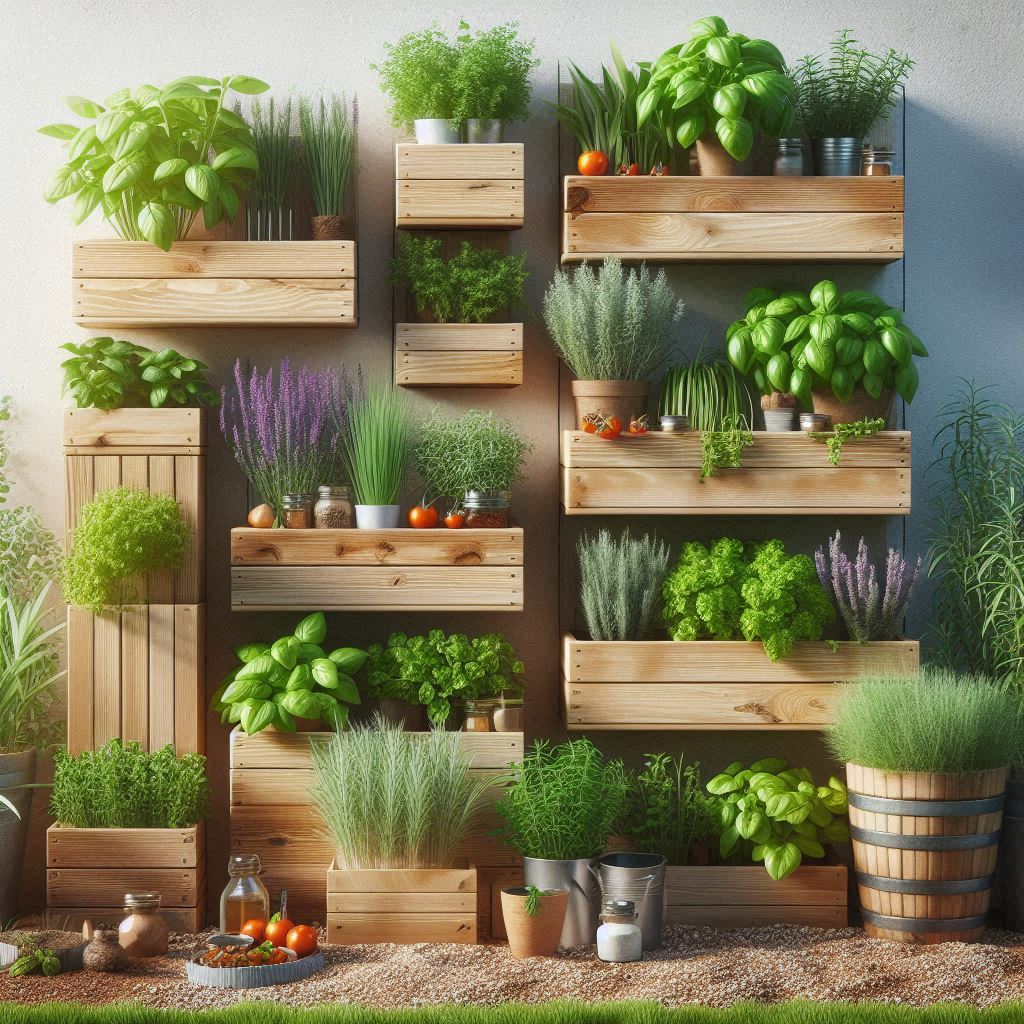
Turn a small space into a thriving herb haven with a vertical garden made from recycled materials.
Materials:
- Recycled materials like wood scraps, old gutters, metal tins, or plastic bottles (depending on your design)
- Pockets for planting (fabric pockets, hanging planters, etc.)
- Screws or nails (if using wood)
- Drill (if using wood)
Estimated Cost: This option can be very budget-friendly, utilizing found or upcycled materials.
Instructions:
- Prepare the base structure: Depending on your chosen materials, create a vertical structure. You can use scrap wood to build a frame, repurpose old gutters by attaching them to a fence or wall, or even use hanging baskets or metal tins stacked vertically.
- Attach planting pockets: Secure fabric pockets specifically designed for vertical gardens, hanging planters, or repurposed containers like plastic bottles with drainage holes to your vertical structure. Ensure they are spaced evenly and securely fastened.
Tips:
- Choose herbs that thrive in containers and prefer moderate sun exposure. Popular choices for vertical gardens include basil, mint, parsley, oregano, and thyme.
- Consider drainage when using recycled materials. If using plastic bottles, ensure they have drainage holes to prevent waterlogging.
- Vertical gardens tend to dry out faster due to increased airflow. Plan to water your herbs more frequently, especially during hot weather.
7. Raised Garden Bed with Built-in Bench:
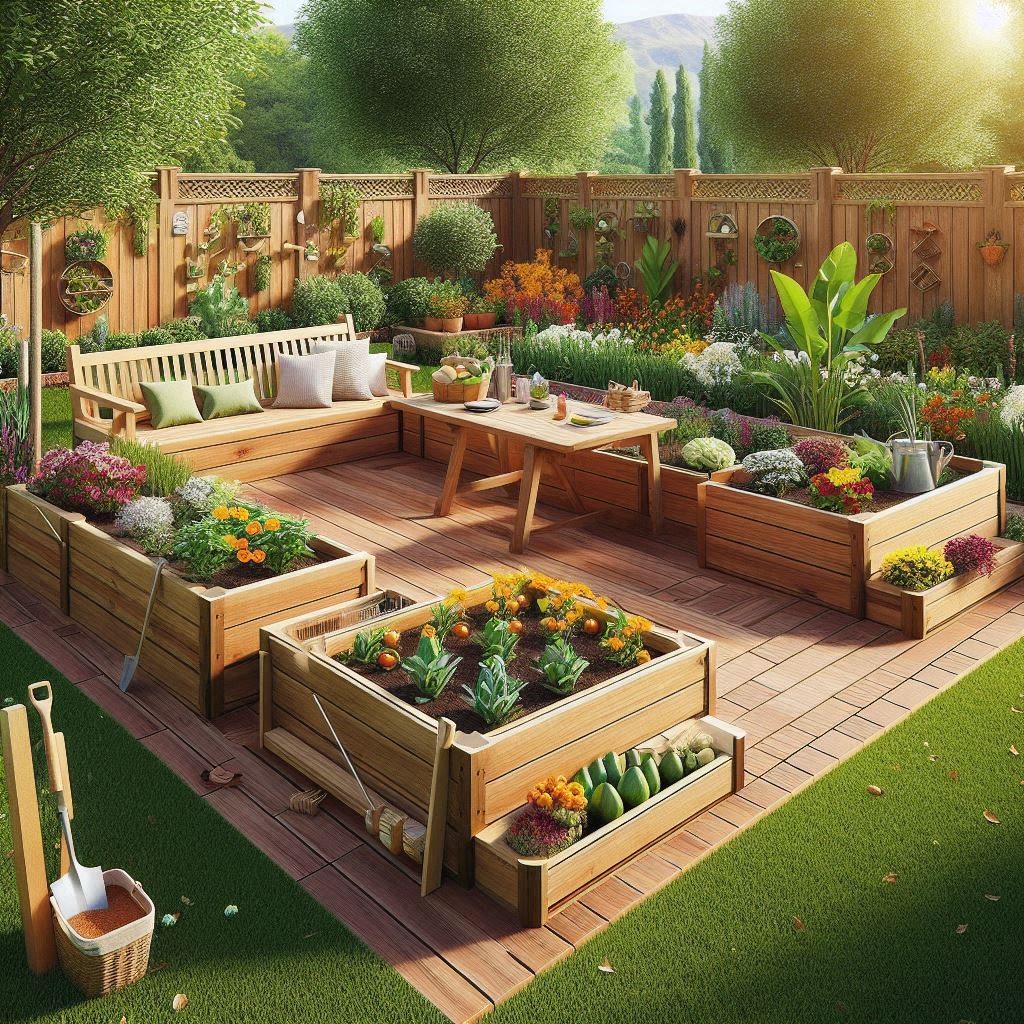
Combine a beautiful garden with a comfortable seating area by building a raised bed with an attached bench.
Materials:
- Lumber (enough for your desired size, typically 1×6 or 2×4 boards for the bed and bench)
- Screws
- Drill
- Saw (optional, if pre-cut lumber isn’t purchased)
- Sandpaper (optional)
Estimated Cost: The cost will vary depending on the size and lumber prices. Expect to pay slightly more than a basic raised bed due to the additional materials for the bench.
Instructions:
- Build the raised bed: Following the instructions for the classic wooden raised bed (plan #1), construct the frame for the garden bed portion.
- Create the bench frame: Cut lumber pieces for the bench seat and backrest. Assemble the frame using screws and pre-drilled pilot holes. Ensure the bench height is comfortable for sitting.
- Attach the bench to the raised bed: Secure the completed bench frame to the back of the raised bed using sturdy brackets or additional lumber pieces. Sand any rough edges for a smooth finish.
Tips:
- Design the bench for comfort. Consider the desired seat height and back support when determining the dimensions of the bench frame.
- You can add a finishing touch by staining or painting both the raised bed and the bench to match your outdoor décor.
- Ensure the bench is securely attached to the raised bed to prevent tipping. Double-check all connections before placing weight on the bench.
8. Wicker Basket Raised Garden Bed:
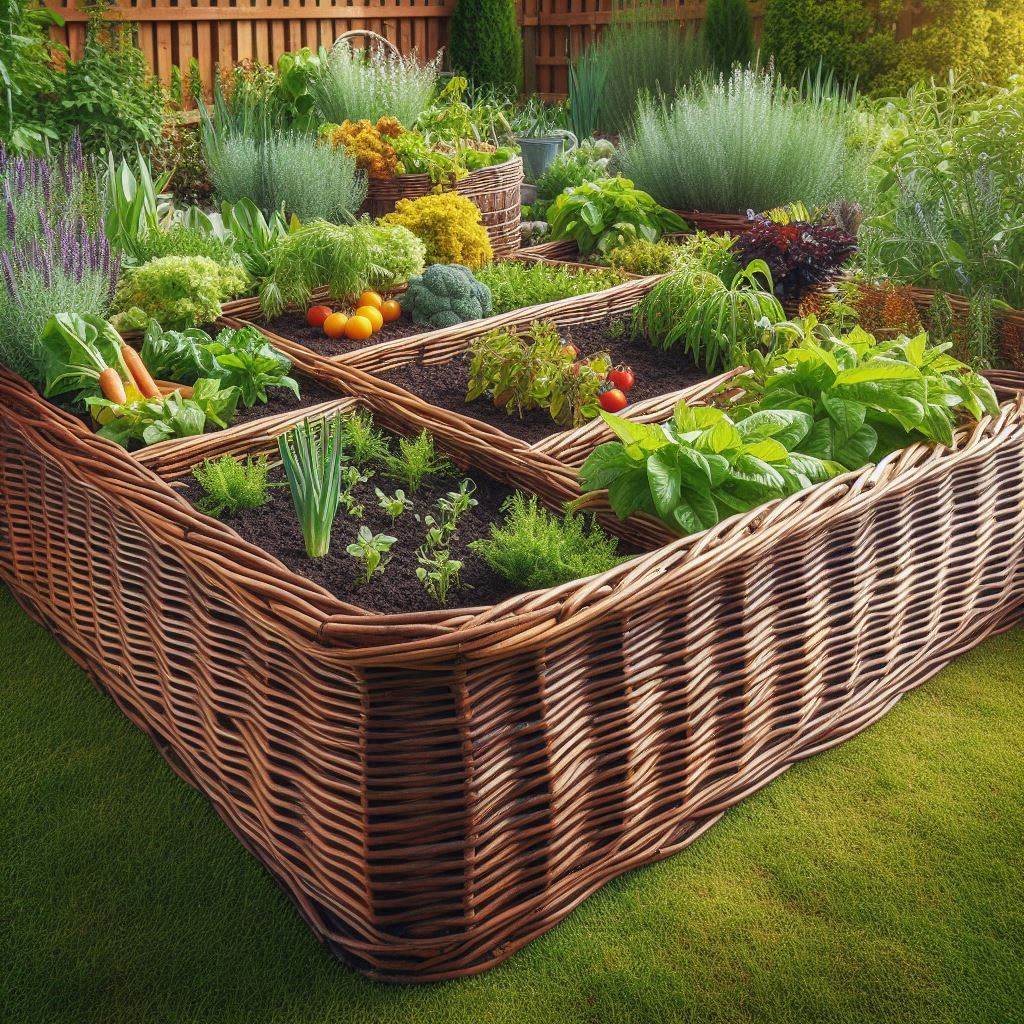
Embrace a whimsical touch with a repurposed wicker basket transformed into a charming raised bed.
Materials:
- Large wicker basket (ensure it has drainage holes or add them yourself)
- Landscape fabric
- Potting mix suitable for your chosen plants
Estimated Cost: This plan is budget-friendly, utilizing a repurposed basket and store-bought potting mix.
Instructions:
- Prepare the basket: Line the bottom of the wicker basket with landscape fabric. This helps retain moisture while preventing soil from leaking out.
- Fill with potting mix: Fill the lined basket with high-quality potting mix specifically formulated for container gardening.
Tips:
- Choose a sturdy wicker basket that can hold the weight of the soil and plants. Avoid baskets with loose weaves or signs of significant wear and tear.
- Wicker baskets dry out quickly, especially in hot weather. Plan to water your plants more frequently compared to traditional raised beds.
- Select plants well-suited for container gardening and choose varieties that won’t outgrow the basket’s size.
9. Cinder Block Raised Garden Bed:

Cinder blocks offer a unique and low-maintenance option for a raised bed.
Materials:
- Cinder blocks (enough for your desired size and number of tiers)
- Landscape fabric
- Optional: Gravel or crushed rock (for drainage)
Estimated Cost: Cinder blocks are relatively inexpensive, making this a budget-friendly option.
Instructions:
- Plan the layout: Determine the desired size and number of tiers for your raised bed. Sketch a layout to visualize the placement of cinder blocks.
- Create the frame: Lay the cinder blocks in a single row for a low bed or stack them in multiple tiers for a taller structure. Leave spaces between the blocks for drainage.
- Line the bottom (optional): If using multiple tiers, consider lining the bottom tier with landscape fabric and adding a layer of gravel or crushed rock to improve drainage.
Tips:
- Wear gloves when handling cinder blocks as they can be rough and heavy.
- Cinder blocks are a porous material and may absorb moisture from the soil. This can be beneficial in dry climates but might require more frequent watering in hot weather.
- To add a decorative touch, you can paint the cinder blocks in a variety of colors to complement your garden design.
10. Tire Raised Garden Bed:
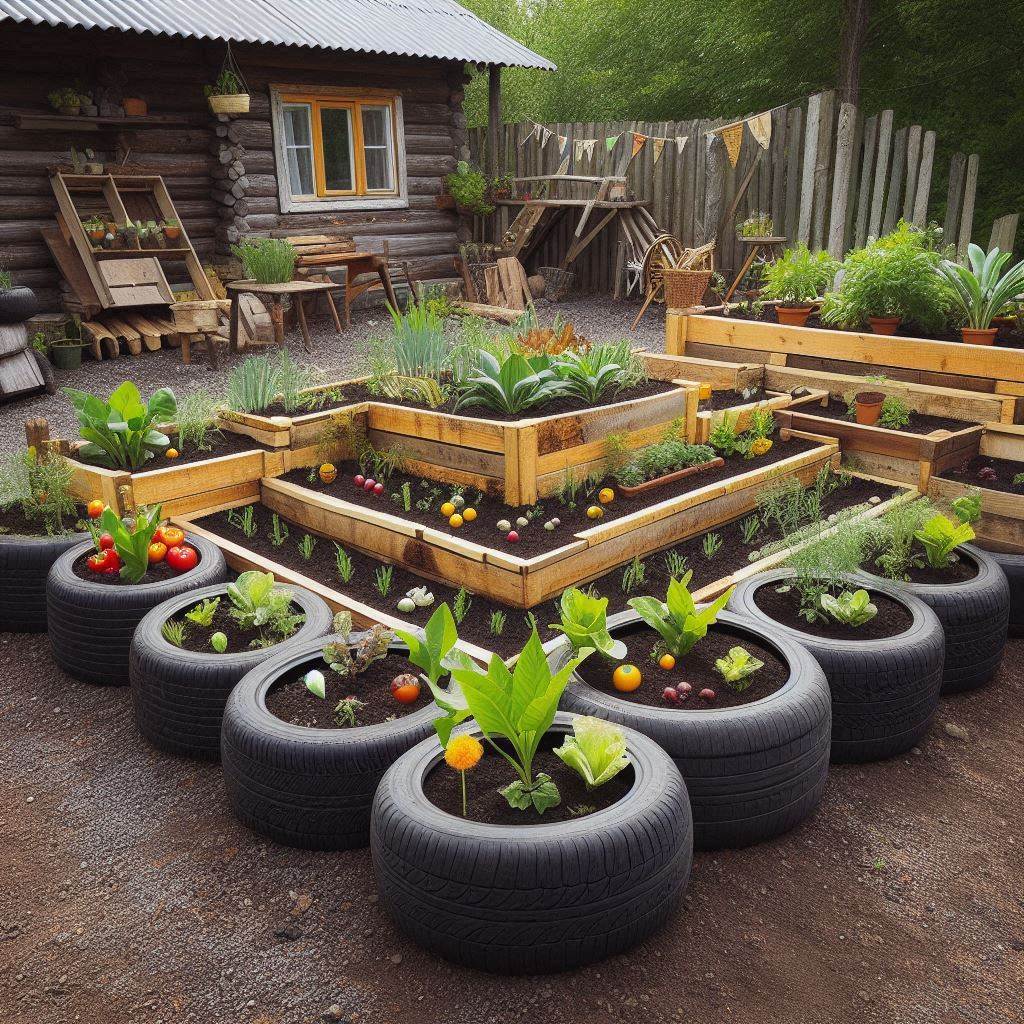
Repurpose old tires into a unique and budget-friendly raised bed option.
Materials:
- Used tires (ensure they are clean and free of debris)
- Utility knife
- Staple gun
- Landscape fabric
- Potting mix
Estimated Cost: This is another budget-friendly option, utilizing used tires and readily available materials.
Instructions:
- Prepare the tires: Use a utility knife to carefully cut the sidewall of the tire, creating a flat surface for planting. Alternatively, stack two whole tires for a taller bed.
- Line the tire (optional): Cut a piece of landscape fabric larger than the tire opening. Secure it to the inner rim of the tire using a staple gun. This helps retain moisture and prevents soil from leaking out.
- Fill with potting mix: Fill the lined tire with high-quality potting mix suitable for your chosen plants.
Tips:
- Only use tires that are free of cracks or damage. Avoid using tires that have been treated with chemicals.
- Ensure the tires have drainage holes in the bottom to prevent waterlogging. You can create drainage holes by poking holes in the base of the tire with a drill.
- Painted tires can add a pop of color to your garden, but choose paint specifically formulated for rubber to avoid cracking or peeling.
11. Stacked Crate Raised Garden Bed:
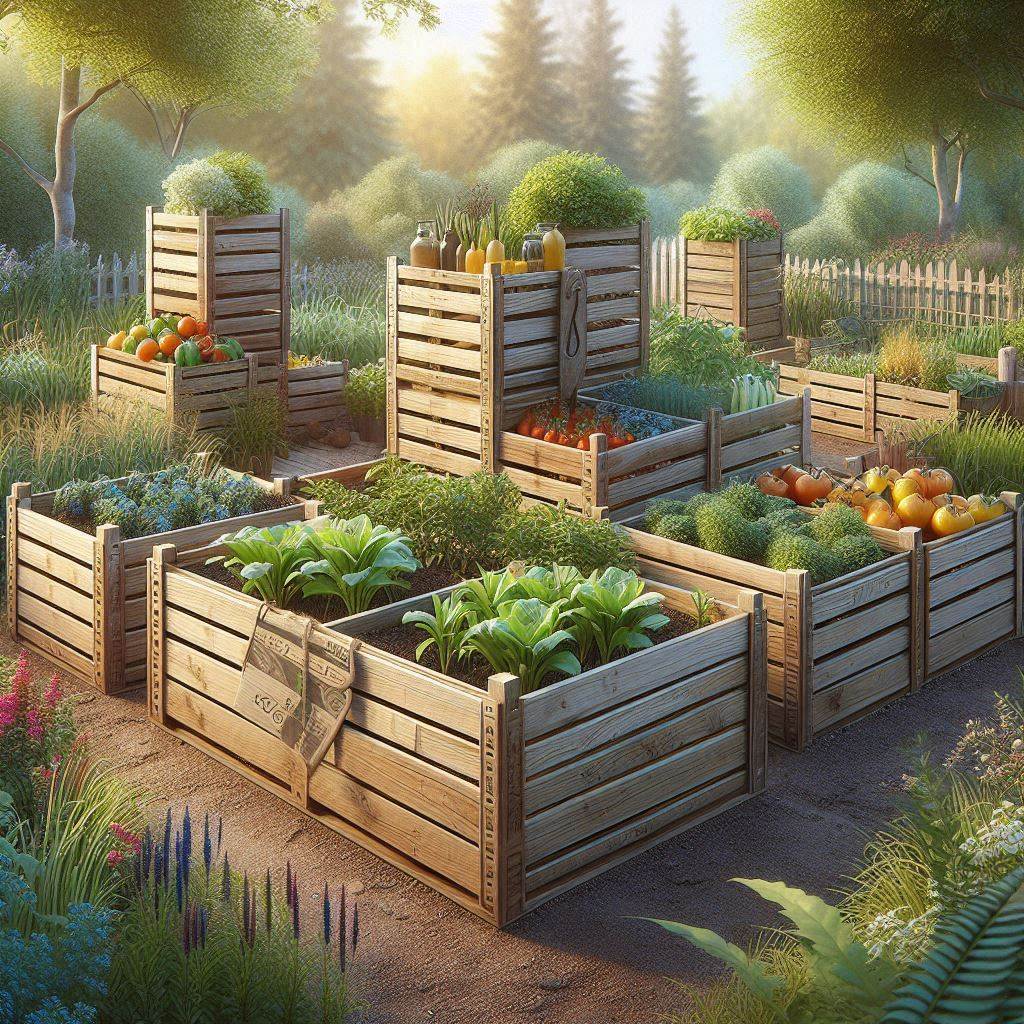
Turn wooden crates into a charming and versatile raised bed option.
Materials:
- Wooden crates (same size or a combination of sizes)
- Landscape fabric
- Potting mix
Estimated Cost: The cost depends on the number and size of crates needed. Look for used crates or consider building your own from scrap wood.
Instructions:
- Prepare the crates: If using used crates, ensure they are clean and free of debris. Line the bottom of each crate with landscape fabric to retain moisture and prevent soil loss.
- Stack the crates: Stack the crates on top of each other to create the desired height for your raised bed. You can use crates of the same size for a uniform look or experiment with different sizes for a more whimsical design.
Tips:
- Choose crates made from untreated wood suitable for gardening. Avoid crates that may have been used for storing chemicals or harmful substances.
- Secure the stacked crates if using them in a windy location. You can zip-tie them together or use brackets for added stability.
- Consider staining or painting the crates in a uniform color for a cohesive look, or get creative and paint each crate a different color for a vibrant display.
12. Half-Barrel Raised Garden Bed:
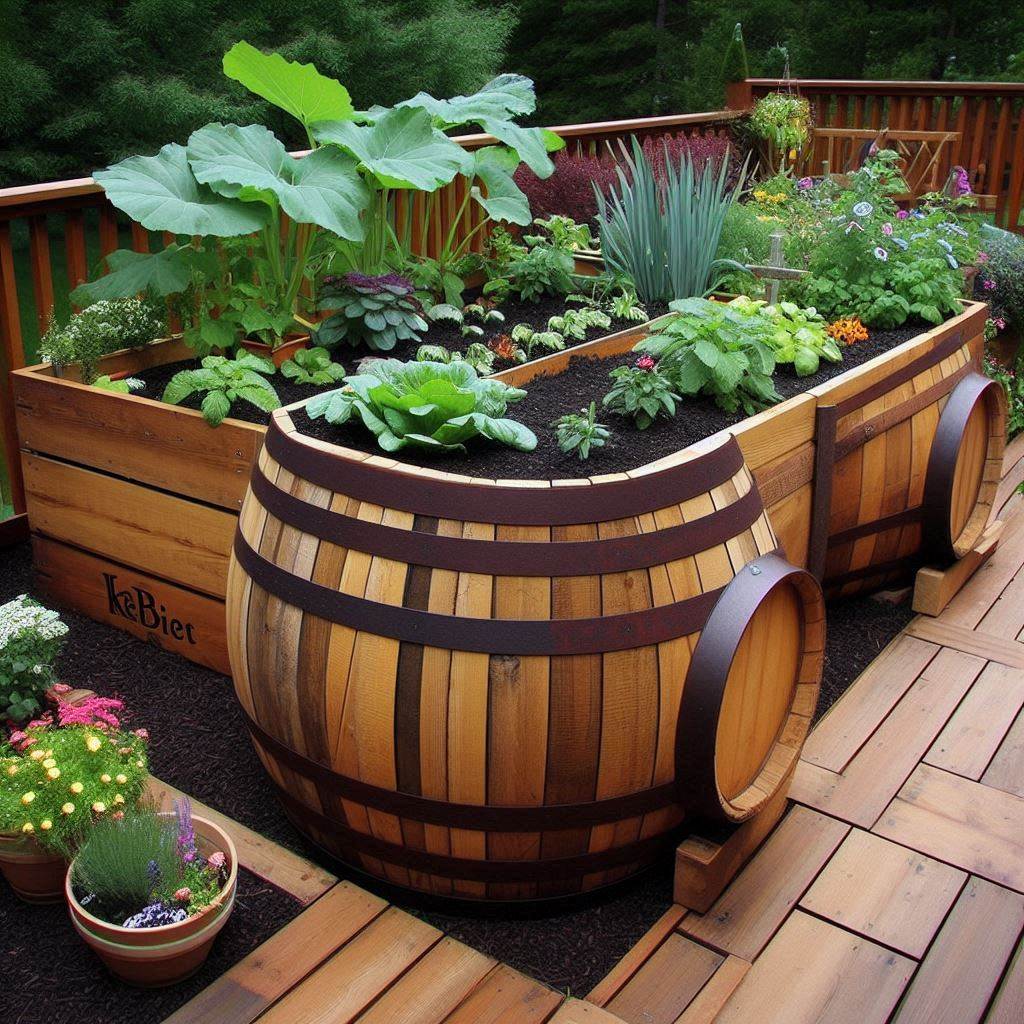
Repurpose a halved wooden barrel into a unique and compact raised bed.
Materials:
- Wooden barrel (ensure it’s untreated and suitable for gardening)
- Saw (optional, if the barrel needs cutting)
- Drill (to create drainage holes)
- Landscape fabric
- Potting mix
Estimated Cost: This option can be budget-friendly if you can find a used barrel at a discount.
Instructions:
- Prepare the barrel: If the barrel is whole, cut it in half horizontally using a saw to create a planting bed. Sand any rough edges.
- Drill drainage holes: Drill several holes in the bottom of the halved barrel to allow for proper drainage.
- Line the barrel (optional): Line the bottom of the barrel with landscape fabric to retain moisture and prevent soil loss.
Tips:
- Choose a barrel made from untreated wood specifically intended for garden use. Avoid barrels that may have contained harmful chemicals.
- Half-barrels are ideal for smaller spaces or growing herbs and compact vegetables.
- To add a decorative touch, paint the outside of the barrel in a color that complements your garden aesthetic.
13. Hanging Pocket Raised Garden Bed:
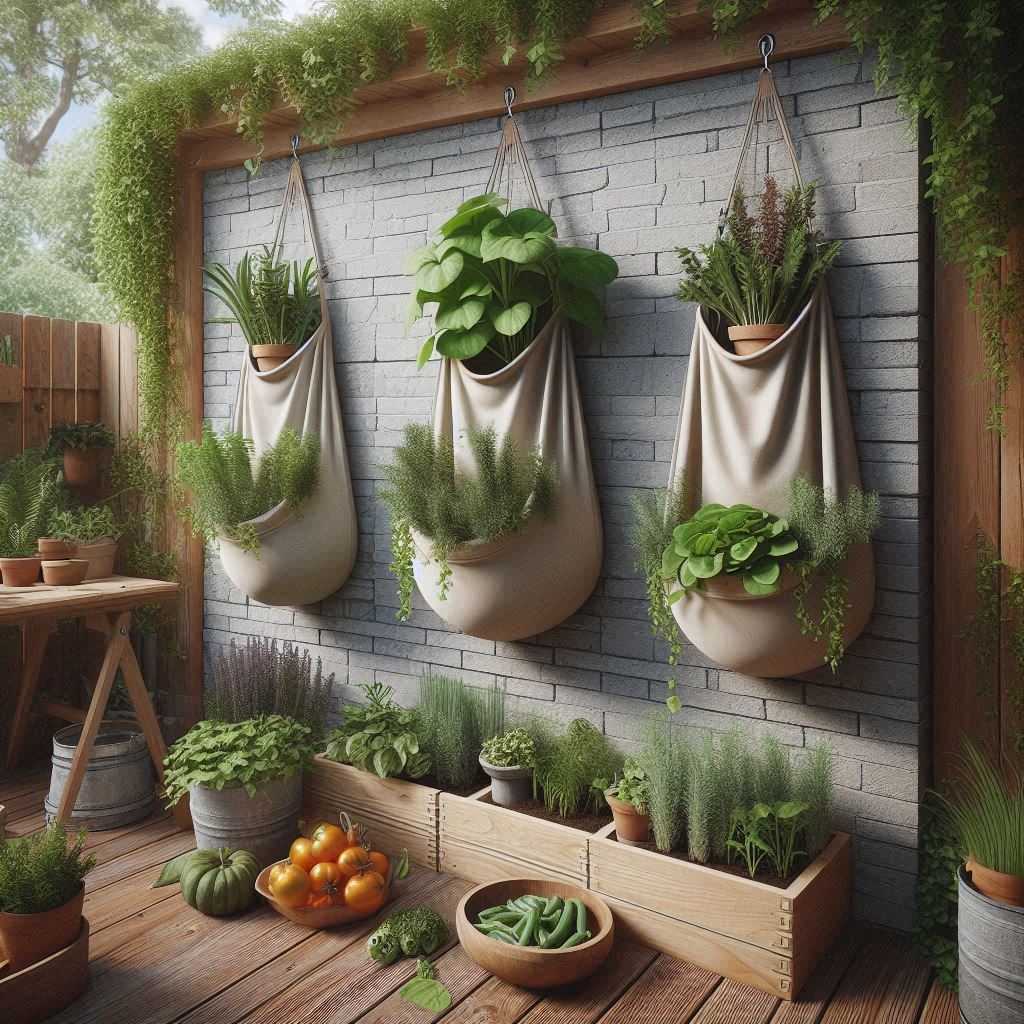
Maximize vertical space with a hanging pocket planter for a unique raised bed solution.
Materials:
- Sturdy hanging planter pockets (made from fabric or breathable material)
- Hooks or brackets for hanging
- Potting mix suitable for your chosen plants
Estimated Cost: The cost varies depending on the number and size of hanging pockets needed.
Instructions:
- Choose a location: Select a sunny spot with a sturdy structure like a fence, wall, or pergola to hang the pockets.
- Fill the pockets: Fill each hanging pocket with high-quality potting mix suitable for your chosen plants. Ensure the pockets have drainage holes to prevent waterlogging.
Tips:
- Choose hanging pockets made from a breathable material that allows for proper drainage and aeration.
- Select plants that thrive in containers and prefer moderate sun exposure. Herbs, trailing flowers, and certain lettuce varieties are well-suited for hanging pocket gardens.
- Water your hanging pockets regularly, as they tend to dry out faster than traditional raised beds due to increased airflow.
14. Repurposed Washing Machine Drum Raised Garden Bed:
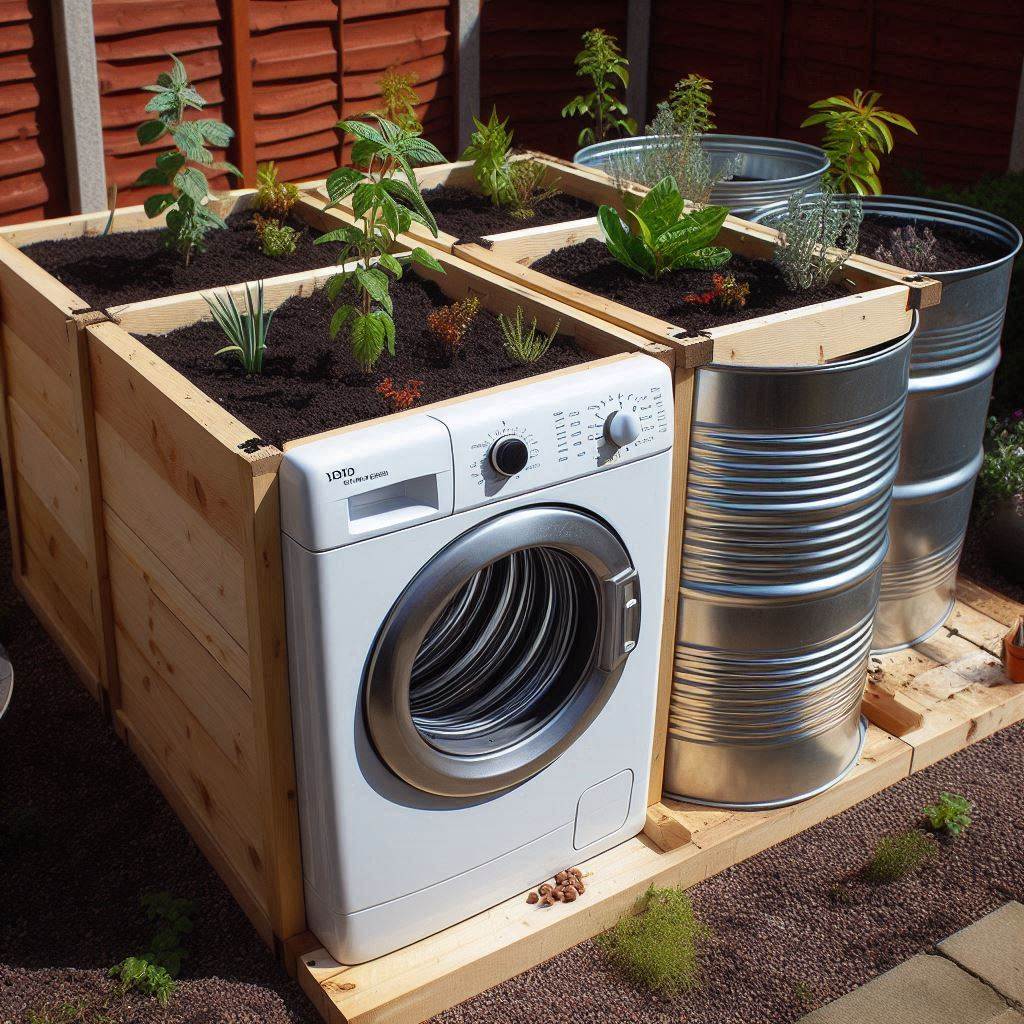
Upcycle an old washing machine drum into a unique and spacious raised bed.
Materials:
- Old washing machine drum (ensure it is clean and free of rust)
- Drainage hose (optional)
- Landscape fabric
- Potting mix
Estimated Cost: This option can be very budget-friendly if you can find a free washing machine drum.
Instructions:
- Prepare the drum: Clean the washing machine drum thoroughly, removing any dirt, debris, or rust. Check for drainage holes in the bottom. If there aren’t any, consider drilling a few for proper drainage. You can also attach a drainage hose to an existing hole if desired.
- Line the drum (optional): Line the bottom of the drum with landscape fabric to retain moisture and prevent soil loss. Fill with potting mix: Fill the lined drum (or unlined drum, if preferred) with high-quality potting mix suitable for your chosen plants.
Tips:
- Only use washing machine drums made from stainless steel or other materials safe for gardening. Avoid drums with excessive rust or damage.
- The large size of a washing machine drum makes it ideal for growing vining vegetables like tomatoes, cucumbers, or melons. You can create a trellis system using stakes and twine to support these climbing plants.
- Consider painting the outside of the washing machine drum in a fun color to add a whimsical touch to your garden.
15. Stacked Terracotta Pot Raised Garden Bed:
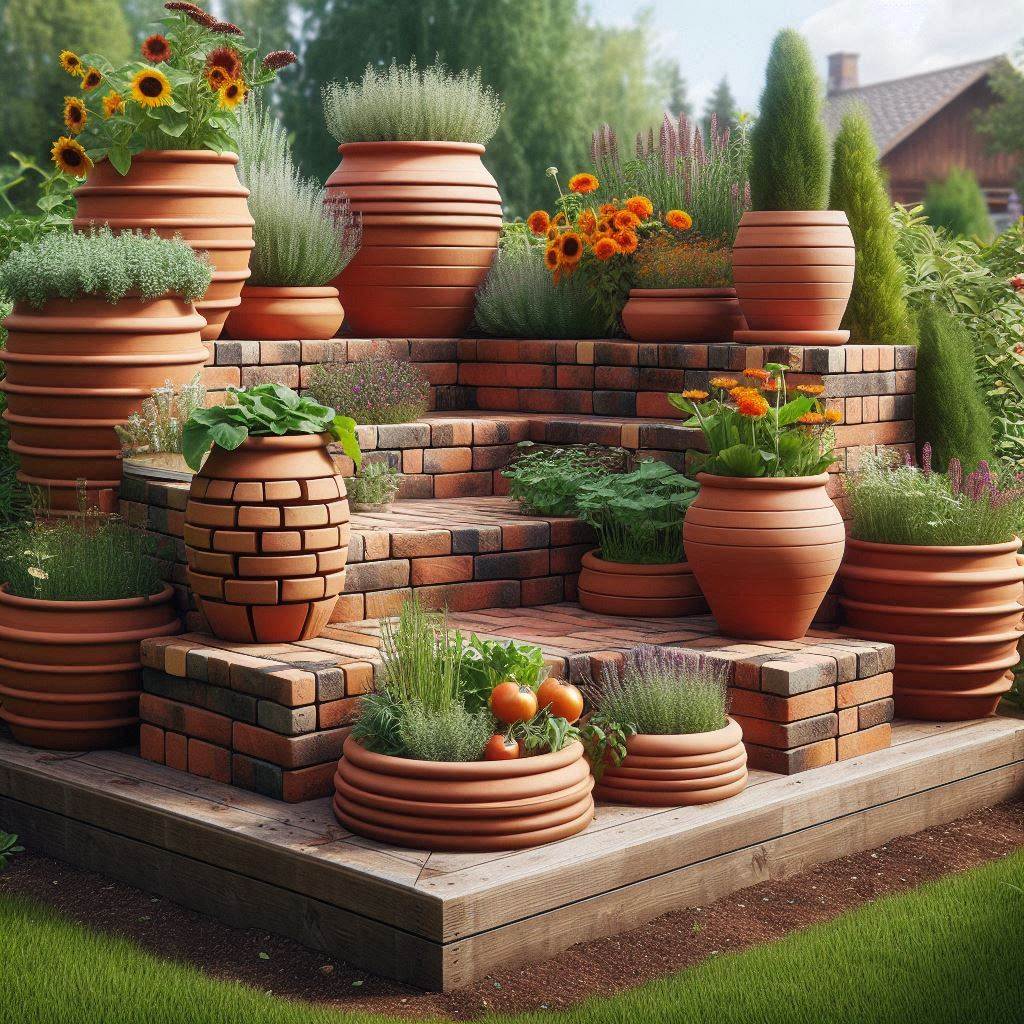
Create a charming and tiered raised bed using a variety of sizes of terracotta pots.
Materials:
- Terracotta pots (various sizes)
- Potting mix suitable for your chosen plants
- Optional: Gravel or crushed rock (for drainage)
Estimated Cost: The cost depends on the number and sizes of terracotta pots needed. Look for used pots at thrift stores or garden centers.
Instructions:
- Select the pots: Choose a variety of terracotta pots in different sizes. Ensure the pots have drainage holes in the bottom.
- Create the base: Use the largest pot as the base of your raised bed. Place a layer of gravel or crushed rock in the bottom of the pot for improved drainage (optional).
- Stack the pots: Stack the remaining terracotta pots on top of the base pot, starting with the second-largest size and working your way down to the smallest pot on top. Nestle the pots within each other to create a stable structure.
Tips:
- Choose terracotta pots made from a sturdy material that can withstand the weight of soil and plants. Avoid cracked or damaged pots.
- Terracotta pots are porous and can dry out quickly, especially in hot weather. Plan to water your plants more frequently compared to traditional raised beds.
- Experiment with different pot sizes and arrangements to create a unique and visually appealing tiered raised bed.
Conclusion
Building your own raised garden bed is a rewarding and cost-effective way to grow fresh produce or beautiful flowers. With these free plans and a little creativity, you can transform your outdoor space into a thriving garden oasis. Don’t be discouraged if you’re a beginner – these plans are designed for ease of construction and require minimal carpentry skills.
Remember, the most important factor is to choose a plan that suits your space, budget, and gardening preferences. Once your raised bed is built, explore the vast world of planting guides and resources available online to get started on your gardening journey. The satisfaction of harvesting your homegrown vegetables or enjoying the fragrance of fresh herbs grown by your own hands is truly unparalleled. So, grab your tools, choose a plan, and get ready to experience the joy of raised bed

